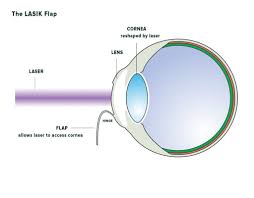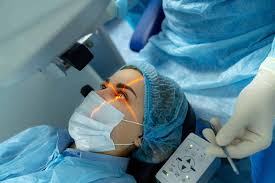Table of Contents
ToggleThe lipid layer thickness of the tear film plays a critical role in the success and comfort of LASIK procedures. It directly affects the stability of the tear film, which is essential for maintaining clear vision and healthy eyes post-surgery.
Understanding the relationship between the lipid layer and LASIK outcomes can help both patients and eye care professionals make informed decisions. This blog explores the role of lipid layer thickness, why it matters for LASIK, and how to manage it for optimal results.
What is the Lipid Layer?
The lipid layer is the outermost layer of the tear film, a thin protective coating that covers the eye’s surface. Comprised of oils secreted by the meibomian glands in the eyelids, this layer prevents the rapid evaporation of tears and contributes to the tear film’s stability. Below the lipid layer lie the aqueous layer (water and soluble proteins) and the mucin layer, which help spread the tear film evenly over the cornea.
Why is the Lipid Layer Important?
The smooth functioning of the lipid layer is vital for several reasons:
- Prevention of Evaporation: It reduces water loss from the tear film, keeping the eyes moist.
- Vision Clarity: A stable tear film ensures an even optical surface for refraction, which is essential for clear vision.
- Eye Comfort: It helps reduce the sensation of dryness by maintaining consistent lubrication.
Issues with the lipid layer can lead to tear film instability, causing problems like dry eye disease (DED)—a common concern for LASIK patients.
LASIK and the Tear Film
LASIK (Laser-Assisted in Situ Keratomileusis) is a widely utilised refractive surgical procedure aimed at correcting visual impairments such as myopia, hyperopia, and astigmatism. During the procedure, a laser reshapes the cornea to improve how light focuses on the retina.
How Does LASIK Impact the Tear Film?
The procedure can disrupt the natural balance of the tear film in the following ways:
- Nerve Damage in the Cornea: LASIK temporarily cuts corneal nerves responsible for stimulating tear production, often leading to dry eye symptoms.
- Tear Film Instability: Changes to the corneal shape can alter the surface area and disrupt the lipid layer’s spread.
- Inflammation: Postoperative inflammation may affect the function of meibomian glands and reduce lipid secretion.
Patients with pre-existing tear film instability or lipid layer deficiency are at higher risk of experiencing post-LASIK dry eye syndrome (DES).
Role of Lipid Layer Thickness in LASIK Outcomes
1. Preoperative Assessment
Before undergoing LASIK, a comprehensive evaluation of the tear film is essential. Measuring lipid layer thickness (LLT) provides critical insights into the tear film’s stability and the likelihood of postoperative complications.
- Diagnostic Tools:
Instruments like tear interferometers or LipiView systems are used to assess LLT. Thinner lipid layers may indicate underlying meibomian gland dysfunction (MGD) or dry eye risks.
- Decision-Making:
For patients with insufficient lipid layers, eye care professionals may recommend treating MGD or addressing dry eye symptoms before scheduling LASIK.
2. Post-LASIK Tear Film Stability
The lipid layer thickness directly influences how well the tear film stabilises post-surgery. A thinner lipid layer increases the likelihood of:
- Tear evaporation.
- Persistent dry eye symptoms.
- Difficulty achieving clear visual outcomes.
On the other hand, a healthy and robust lipid layer promotes faster healing and better comfort for the patient.
3. Managing Post-LASIK Dry Eye
Postoperative dry eye syndrome is one of the most common complaints after LASIK. Enhancing lipid layer function can significantly improve patient outcomes.
- Topical Lipid-Based Eye Drops:
Drops containing lipid agents mimic the natural oils in the tear film and support tear film stability. They are especially beneficial for patients with lipid layer insufficiency.
- Meibomian Gland Therapies:
Treatments like LipiFlow can unclog meibomian glands and restore normal oil secretion, strengthening the lipid layer.
- Omega-3 Supplementation:
Dietary omega-3 fatty acids are known to improve meibomian gland function and lipid composition in tears.
Factors Affecting Lipid Layer Thickness
Several internal and external factors can influence the thickness and quality of the lipid layer:
Age and Hormonal Changes
Ageing and hormonal fluctuations (e.g., menopause) are linked to decreased meibomian gland activity. Such changes can thin the lipid layer, making older LASIK patients more susceptible to tear film instability.
Meibomian Gland Dysfunction (MGD)
MGD occurs when the glands responsible for oil secretion become blocked or dysfunctional. This is one of the leading causes of a compromised lipid layer and evaporative dry eye.
Environmental Factors
- Prolonged exposure to air conditioning, screens, or dry climates speeds up tear evaporation.
- Post-LASIK patients should protect their eyes with sunglasses or use a humidifier in dry environments to maintain lipid stability.
Ocular Surface Conditions
Conditions like blepharitis (inflammation of the eyelids) can compromise the quality of oils secreted into the tear film. Addressing these underlying issues is critical before LASIK.
Enhancing Lipid Layer Thickness Before LASIK
For patients with insufficient LLT, preoperative interventions can make a significant difference in LASIK outcomes.
Warm Compresses
Applying warm compresses helps loosen dried oils and unclog meibomian glands, improving lipid secretion.
Lid Hygiene
Maintaining clean eyelids by using specialised cleansing products reduces inflammation and promotes healthier gland function.
Prescription Therapies
Medications like cyclosporine (Restasis) or lifitegrast (Xiidra) may be prescribed to treat dry eye-related inflammation and stabilise the tear film.
Artificial Tears
Lipid-enriched artificial tears provide immediate relief for evaporative dry eye and support lipid layer replenishment.
These steps can help prepare the ocular surface for LASIK and reduce the risk of postoperative complications.
Advances in LASIK Procedures and Lipid Layer Considerations
Modern LASIK advancements are addressing tear film disruptions more effectively:
- SMILE (Small Incision Lenticule Extraction):
A newer LASIK alternative, SMILE, affects corneal nerves less extensively, potentially reducing the risk of postoperative dry eye compared to traditional LASIK.
- Personalised Treatment Plans:
Advanced diagnostic tools enable eye surgeons to customise LASIK procedures based on the patient’s tear film health, minimising complications.
These innovations highlight the growing importance of lipid layer assessments in optimising LASIK outcomes.
Key Takeaways for Patients and Professionals
1. Preoperative Evaluation is Essential
Understanding lipid layer thickness is crucial for predicting LASIK success and minimising postoperative dryness.
2. Customised Treatments Reduce Risk
Addressing lipid deficiencies with preoperative therapies leads to better comfort and recovery for patients.
3. Postoperative Care Matters
Regular use of lipid-based eye drops, alongside attention to meibomian gland health, ensures a faster and more effective healing process.
4. Advancements in LASIK Minimise Issues
Emerging LASIK technologies are improving outcomes for patients prone to tear film instability.
Prioritise Lipid Layer Health for LASIK Success
The lipid layer thickness plays an indispensable role in LASIK by ensuring stable tears, clearer vision, and improved postoperative comfort. Both patients and eye care professionals should prioritise a comprehensive tear film assessment and targeted therapies to maximise the success of this life-changing procedure.
For those considering LASIK, consult an eye care professional to evaluate your tear film health and determine the best course of action.













